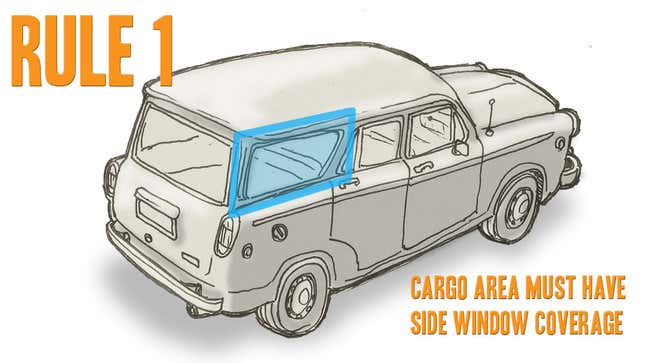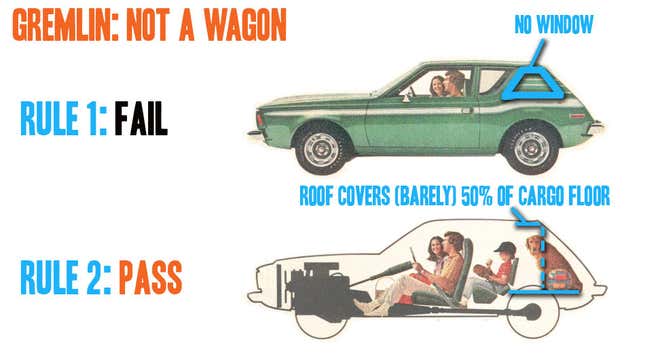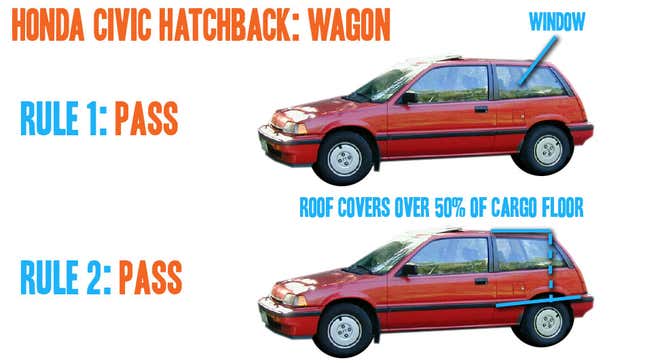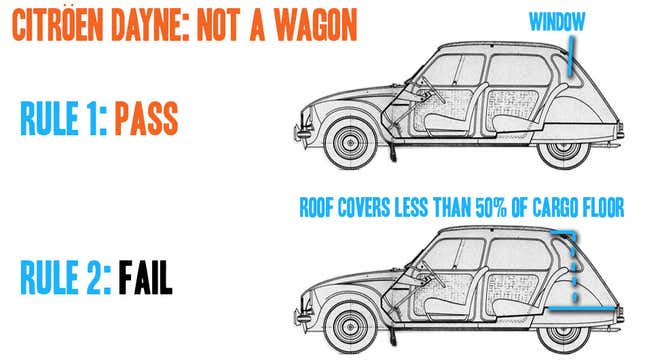The other day I posted about why we call station wagons “station wagons”, and in the comments I noticed a fair amount of discussion in the comments about whether or not certain cars were officially wagons, or just hatchbacks. Sure, it’s a question a child might ask, but it’s not a childish question.
So what is the difference between a hatchback and a station wagon?
I’ve had arguments with my wife about this, and while the only thing I was able to convince her of was that she was dealing with an idiot, I’m hopeful I’ll have something more useful for you, fellow Jalops. See, I’ve given this matter a good amount of thought, and I think I’ve come up with a good set of testable, quantifiable rules so you can make accurate, confident wagon/hatchback assessments. Of course, I’m not going to pretend this is the absolute only way you can think about this, but for the sake of argument let’s just say I found these rules inscribed on golden tablets and I’m pretty sure some deity or other wrote them.
First off, before we get to the rules, let’s just lay out some basic parameters. First, size is not a factor. These rules assume a wagon can be Fiat Giardiniera sized or Buick Estate Wagon sized. Next, it has to have some sort of hood, even if there’s no engine under it. That means no vans, including Volkswagen’s euphemistically named 60s era “Station Wagon” that we all know was a Microbus. Third, shooting brakes count, so two door vehicles can be classified as wagons as well. Oh, and these are all car-chassis vehicles– no SUVs for true wagonhood. Okay, let’s get to the rules.

Rule 1. The cargo area of an actual station wagon must have its own associated side window area, either via separate side windows, or, in the case of shooting brakes, a portion of an elongated rear side window.
Follow me on this one? Without these windows, we’re entering into van territory. I’ll even count the kooky bubble windows of things like the Pinto Cruiser Wagon. Volvo P1800ES, Reliant Scimitars, VW Foxes, all okay, with their long side windows. This is a big differentiator with 5-door hatches, which usually lack cargo-area side windows.

Rule 2. The roofline must extend past the passenger seating area and continue on, unbroken, to cover at least 50% of the area of the rear cargo floor.
This rule is the big one, really. This rule is why something like the four-door Saab 900, a very usable hatchback, is not a true wagon. Same goes for that Hyundai Elantra someone posted in the comments. Not wagons; they just don’t have enough roof over the cargo area. Now, the Audi A3 posted in the comments? Wagon. So is the Nissan Pulsar Sportback also seen in the comments.
Originally, I had a 3rd rule about the ratio of the length of the roof to the angle or the rear of the car (be it door or hatch), but I’ve since simplified the rules down to two. I know there are folks who feel a wagon needs a rear that’s closer to vertical, but I feel a wagon can have a steeply raked rear as long as there is enough roofline to satisfy rule 2.
Let’s test these rules with some tricky cars:

• AMC Gremlin. This one is unusual because it just satisfies rule 2, but not rule 1. That roof breaks into the slope of the rear end at just about halfway down the (admittedly meager) cargo floor, but, as there is no side window coverage for the cargo area, we have no wagon. Just a hatchback. Many 3rd generation and up VW Golfs, with their thick C pillars and near-vertical rears, fall into this category as well. In the case of the Gremlin, I bet an hour with a cutting torch, some plexiglass and epoxy could punch your W-card, though.

• 3rd generation Honda Civic Hatchback. Ha! It’s a wagon. The rear side window extends to serve the cargo area, the roof easily covers more than 50% of the cargo floor. Classic shooting brake.

• Citröen Dayne. This one’s sort of close. It satisfies Rule 1, as later ones did gain an extra pair of rear side windows, and the shape, quite hatchback-looking, seems to have the roof extend less than 50% of the cargo floor. I may need someone lucky enough to have one of these to whip out the tape measure and give us an official call, but that’s what it looks like. If that rear seat position is adjustable, a few inches forward could possibly tip this one into the wagon camp.
I hope this helps. I’m sure plenty of you will disagree which is fine, just post your rules or amendments or examples that make me look like an ass in the comments and we’ll get this all sorted out. PERMANENTLY.